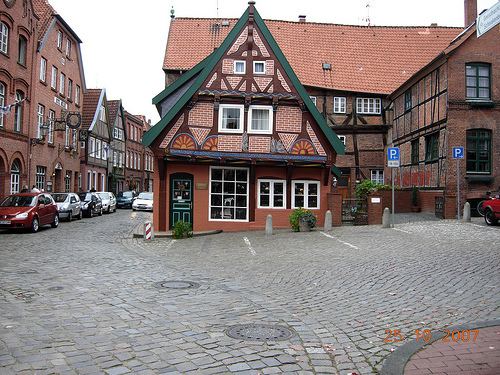Country Germany District Lauenburg Time zone CET/CEST (UTC+1/+2) Population 11,436 (31 Dec 2008) | State Schleswig-Holstein Elevation 49 m (161 ft) Postal codes 21481 Local time Monday 1:50 PM | |
 | ||
Weather 7°C, Wind SE at 10 km/h, 56% Humidity Points of interest Elbschifffahrtsmuseum, Hohes Elbufer zwischen, Lauenburger Schloss, Lauenburger Rufer, Palmschleuse | ||
Lauenburg ( ), or Lauenburg an der Elbe (Lauenburg/Elbe), is a town in the state of Schleswig-Holstein, Germany. It is situated on the northern bank of the river Elbe, east of Hamburg. It is the southernmost town of Schleswig-Holstein and belongs to the Kreis (district) of Herzogtum Lauenburg. Lauenburg had a recorded population on 31 December 2013 of 11,253.
Contents
- Map of 21481 Lauenburg Germany
- History
- Culture and sights
- Notable residents
- International relations
- References
Map of 21481 Lauenburg, Germany
History
The town was founded in 1182 by Bernard of Ascania, the ancestor of the Dukes of Lauenburg. It took its name from that of the castle of Lowenborch (erected here between 1181 and 1182), deriving from Lave, the Polabian-language name of the Elbe (compare modern Czech Labe).
Saxe-Lauenburg was a duchy until 1 July 1876, when it was incorporated into the Royal Prussian Province of Schleswig-Holstein. Lauenburg served as the ducal capital until 1616, when the castle burnt down. In 1619 the capital was moved to Ratzeburg. The area of the duchy was roughly identical with that of today's district. In medieval times Lauenburg was a waypoint on the Old Salt Route, while today it is the southern terminus of the Elbe-Lübeck Canal.
Following the Napoleonic Wars, Lauenburg was ceded by Prussia to Denmark in exchange for the region of Pomerania.
Between 1945 and 1982 Lauenburg served as West German inner German border crossing for cars travelling along Bundesstraße 5 between the Soviet Zone of occupation in Germany (till 1949, thereafter the East German Democratic Republic, or West Berlin and the British zone of occupation (till 1949) and thereafter the West German Federal Republic of Germany. The traffic was subject to the Interzonal traffic regulations, that between West Germany and West Berlin followed the special regulations of the Transit Agreement (1972).
Culture and sights
Lauenburg is a notable old town with a number of historic buildings from the 17th century and earlier. In the past these houses were mostly the homes of sailors. Today, the area appeals to artists as well as tourists. Furthermore, the Maria-Magdalenen Church, built in the 13th century is another attraction of the old town of Lauenburg. The old town is nestled at the bottom of about 50 meter high bluffs. The picturesque narrow streets up the hill lead to the so-called "upper town" where Lauenburg Castle is located. The old Lauenburg Castle used to be the residence of the Dukes of Lauenburg and the political centre of the Dukedom. Over the century most parts were destroyed and replaced by modern buildings. Though, the old castle tower remains till today. Nowadays, the castles serves as city and municipal administration. A walk up to the castle is worth the effort though, because of the view. One cannot only see the beautiful river Elbe and the old town of Lauenburg, but also the flat marshland of Lower-Saxony on the southern shore of the Elbe, which used to belong to the duchy until it was ceded to the then neighbouring Kingdom of Hanover in 1814. On a clear day it is possible to see as far as Lüneburg, about 25 km (16 mi) southwest of Lauenburg. Another historic sight of Lauenburg is the "Palmschleuse", a historic river lock, originally built in 1398 and renewed in the 17th century. It is the oldest such lock in Europe.
Notable residents
International relations
Lauenburg is twinned with:
